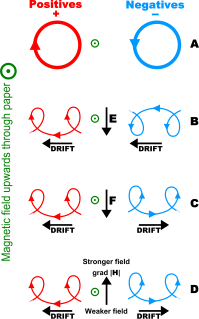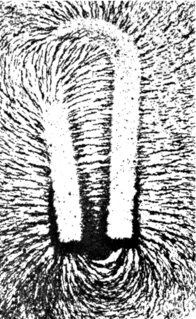This page is based on this
Wikipedia article Text is available under the
CC BY-SA 4.0 license; additional terms may apply.
Images, videos and audio are available under their respective licenses.

In physics the Lorentz force is the combination of electric and magnetic force on a point charge due to electromagnetic fields. A particle of charge q moving with a velocity v in an electric field E and a magnetic field B experiences a force of

In fluid dynamics, the baroclinity of a stratified fluid is a measure of how misaligned the gradient of pressure is from the gradient of density in a fluid. In meteorology a baroclinic atmosphere is one for which the density depends on both the temperature and the pressure; contrast this with a barotropic atmosphere, for which the density depends only on the pressure. In atmospheric terms, the barotropic zones of the Earth are generally found in the central latitudes, or tropics, whereas the baroclinic areas are generally found in the mid-latitude/polar regions.

Physical geodesy is the study of the physical properties of the gravity field of the Earth, the geopotential, with a view to their application in geodesy.
In mathematics, the covariant derivative is a way of specifying a derivative along tangent vectors of a manifold. Alternatively, the covariant derivative is a way of introducing and working with a connection on a manifold by means of a differential operator, to be contrasted with the approach given by a principal connection on the frame bundle – see affine connection. In the special case of a manifold isometrically embedded into a higher-dimensional Euclidean space, the covariant derivative can be viewed as the orthogonal projection of the Euclidean derivative along a tangent vector onto the manifold's tangent space. In this case the Euclidean derivative is broken into two parts, the extrinsic normal component and the intrinsic covariant derivative component.

Scalar potential, simply stated, describes the situation where the difference in the potential energies of an object in two different positions depends only on the positions, not upon the path taken by the object in traveling from one position to the other. It is a scalar field in three-space: a directionless value (scalar) that depends only on its location. A familiar example is potential energy due to gravity.

In physics, the motion of an electrically charged particle such as an electron or ion in a plasma in a magnetic field can be treated as the superposition of a relatively fast circular motion around a point called the guiding center and a relatively slow drift of this point. The drift speeds may differ for various species depending on their charge states, masses, or temperatures, possibly resulting in electric currents or chemical separation.
In differential geometry, the four-gradient
is the four-vector analogue of the gradient
from vector calculus.

The mathematics of general relativity refers to various mathematical structures and techniques that are used in studying and formulating Albert Einstein's theory of general relativity. The main tools used in this geometrical theory of gravitation are tensor fields defined on a Lorentzian manifold representing spacetime. This article is a general description of the mathematics of general relativity.
In plasma physics, an ion acoustic wave is one type of longitudinal oscillation of the ions and electrons in a plasma, much like acoustic waves traveling in neutral gas. However, because the waves propagate through positively charged ions, ion acoustic waves can interact with their electromagnetic fields, as well as simple collisions. In plasmas, ion acoustic waves are frequently referred to as acoustic waves or even just sound waves. They commonly govern the evolution of mass density, for instance due to pressure gradients, on time scales longer than the frequency corresponding to the relevant length scale. Ion acoustic waves can occur in an unmagnetized plasma or in a magnetized plasma parallel to the magnetic field. For a single ion species plasma and in the long wavelength limit, the waves are dispersionless with a speed given by
The Grad–Shafranov equation is the equilibrium equation in ideal magnetohydrodynamics (MHD) for a two dimensional plasma, for example the axisymmetric toroidal plasma in a tokamak. This equation takes the same form as the Hicks equation from fluid dynamics. This equation is a two-dimensional, nonlinear, elliptic partial differential equation obtained from the reduction of the ideal MHD equations to two dimensions, often for the case of toroidal axisymmetry. Taking
as the cylindrical coordinates, the flux function
is governed by the equation,

In physics, Larmor precession is the precession of the magnetic moment of an object about an external magnetic field. Objects with a magnetic moment also have angular momentum and effective internal electric current proportional to their angular momentum; these include electrons, protons, other fermions, many atomic and nuclear systems, as well as classical macroscopic systems. The external magnetic field exerts a torque on the magnetic moment,
The gyroradius is the radius of the circular motion of a charged particle in the presence of a uniform magnetic field. In SI units, the gyroradius is given by

In stellar physics, the Jeans instability causes the collapse of interstellar gas clouds and subsequent star formation, named after James Jeans. It occurs when the internal gas pressure is not strong enough to prevent gravitational collapse of a region filled with matter. For stability, the cloud must be in hydrostatic equilibrium, which in case of a spherical cloud translates to:

A pinch is the compression of an electrically conducting filament by magnetic forces. The conductor is usually a plasma, but could also be a solid or liquid metal. Pinches were the first type of device used for controlled nuclear fusion.
In fluid mechanics and mathematics, a capillary surface is a surface that represents the interface between two different fluids. As a consequence of being a surface, a capillary surface has no thickness in slight contrast with most real fluid interfaces.
The Weibel instability is a plasma instability present in homogeneous or nearly homogeneous electromagnetic plasmas which possess an anisotropy in momentum (velocity) space. This anisotropy is most generally understood as two temperatures in different directions. Burton Fried showed that this instability can be understood more simply as the superposition of many counter-streaming beams. In this sense, it is like the two-stream instability except that the perturbations are electromagnetic and result in filamentation as opposed to electrostatic perturbations which would result in charge bunching. In the linear limit the instability causes exponential growth of electromagnetic fields in the plasma which help restore momentum space isotropy. In very extreme cases, the Weibel instability is related to one- or two-dimensional stream instabilities.
Gyrokinetics is a theoretical framework to study plasma behavior on perpendicular spatial scales comparable to the gyroradius and frequencies much lower than the particle cyclotron frequencies.
These particular scales have been experimentally shown to be appropriate for modeling plasma turbulence. The trajectory of charged particles in a magnetic field is a helix that winds around the field line. This trajectory can be decomposed into a relatively slow motion of the guiding center along the field line and a fast circular motion, called gyromotion. For most plasma behavior, this gyromotion is irrelevant. Averaging over this gyromotion reduces the equations to six dimensions rather than the seven. Because of this simplification, gyrokinetics governs the evolution of charged rings with a guiding center position, instead of gyrating charged particles.
In mathematical physics, the Belinfante–Rosenfeld tensor is a modification of the energy–momentum tensor that is constructed from the canonical energy–momentum tensor and the spin current so as to be symmetric yet still conserved.
The Farley–Buneman instability, or FB instability, is a microscopic plasma instability named after Donald T. Farley and Oscar Buneman. It is similar to the ionospheric Rayleigh-Taylor instability.



















